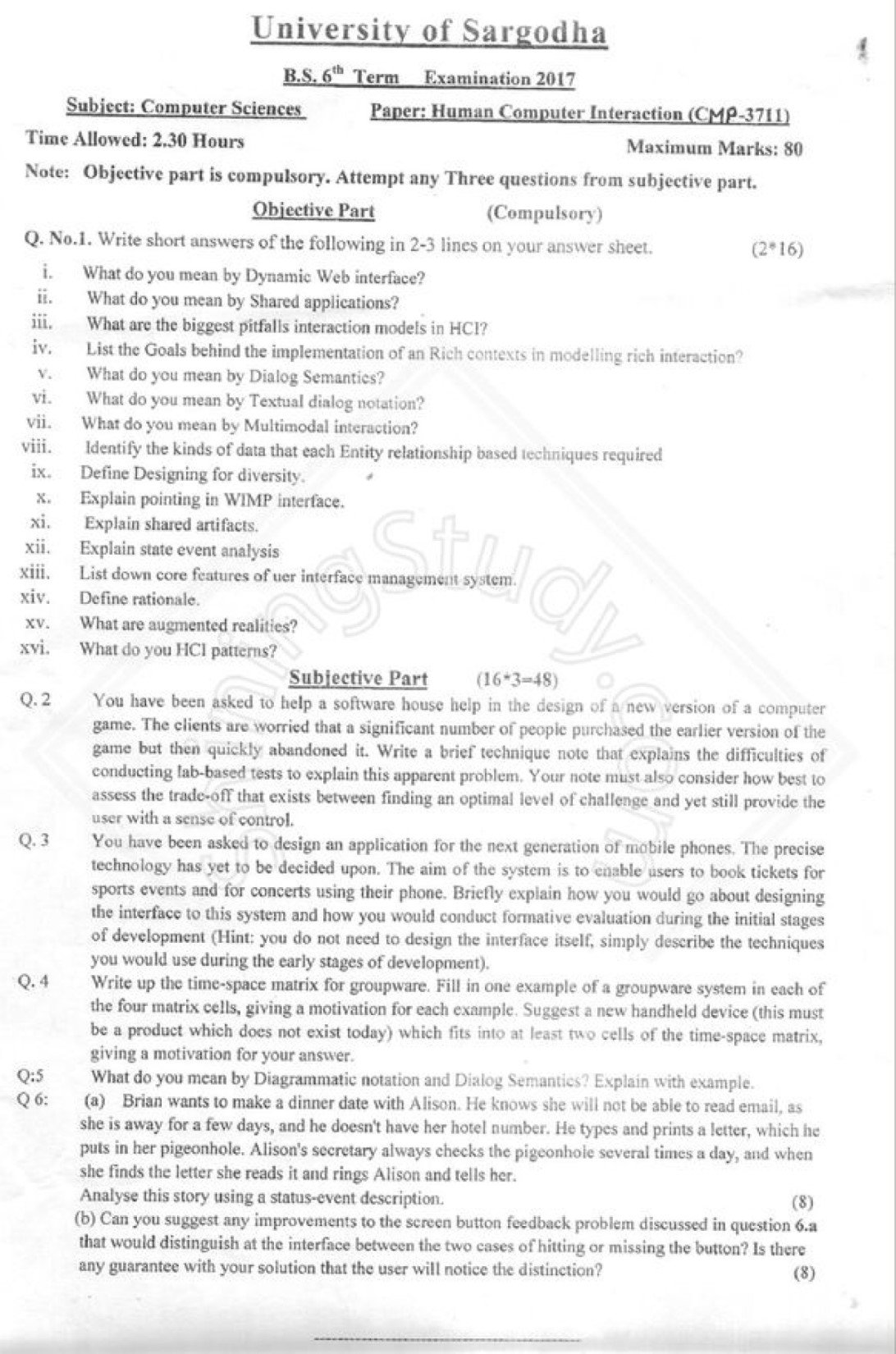Human Computer Interaction BSCS 6th Term Past Paper 2017 UOS

University of Sargodha
B.S. 6th Term Examination 2017
Subject: Computer Sciences
Paper: Human Computer Interaction (CMP: 3711)
Maximum Marks: 80
Time Allowed: 2:30 Hours
Objective Part (Compulsory)
Q. No.1 Write short answers of the following in 2-3 lines on your answer sheet. (2×16)
i. What do you mean by Dynamic Web interface?
ii. What do you mean by Shared applications?
iii. What are the biggest pitfalls interaction models in HCI?
iv. List the goals behind the implementation of Rich contexts in modelling rich interaction?
v. What do you mean by Dialog Semantics?
vi. What do you mean by Textual dialog notation?
vii. What do you mean by Multimodal interaction?
viii. Identify the kinds of data that each Entity relationship based techniques require.
ix. Define Designing for diversity.
x. Explain pointing in WIMP interface.
xi. Explain shared artifacts.
xii. Explain state event analysis.
xiii. List down core features of user interface management system.
xiv. Define rationale.
xv. What are augmented realities?
xvi. What do you mean by HCI patterns?
Subjective Part (16×3=48)
Q.2 You have been asked to help a software house in the design of a new version of a computer game. The clients are worried that a significant number of people purchased the earlier version of the game but then quickly abandoned it. Write a brief technique note that explains the difficulties of conducting lab-based tests to explain this apparent problem. Your note must also consider how best to assess the trade-off that exists between finding an optimal level of challenge and still providing the user with a sense of control.
Q.3 You have been asked to design an application for the next generation of mobile phones. The precise technology has yet to be decided upon. The aim of the system is to enable users to book tickets for sports events and for concerts using their phone. Briefly explain how you would go about designing the interface to this system and how you would conduct formative evaluation during the initial stages of development. (Hint: you do not need to design the interface itself, simply describe the techniques you would use during the early stages of development).
Q.4 Write up the time-space matrix for groupware. Fill in one example of a groupware system in each of the four matrix cells, giving a motivation for each example. Suggest a new handheld device (this must be a product which does not exist today) which fits into at least two cells of the time-space matrix, giving a motivation for your answer.
Q.5 What do you mean by Diagrammatic notation and Dialog Semantics? Explain with example.
Q.6
(a) Brian wants to make a dinner date with Alison. He knows she will not be able to read email, as she is away for a few days, and he doesn’t have her hotel number. He types and prints a letter, which he puts in her pigeonhole. Alison’s secretary always checks the pigeonhole several times a day, and when she finds the letter she reads it and rings Alison and tells her. Analyse this story using a status-event description. (8)
(b) Can you suggest any improvements to the screen button feedback problem discussed in question 6.a that would distinguish at the interface between the two cases of hitting or missing the button? Is there any guarantee with your solution that the user will notice the distinction? (8)
For more past papers and HCI resources, visit Shining Study – Past Papers Collection
